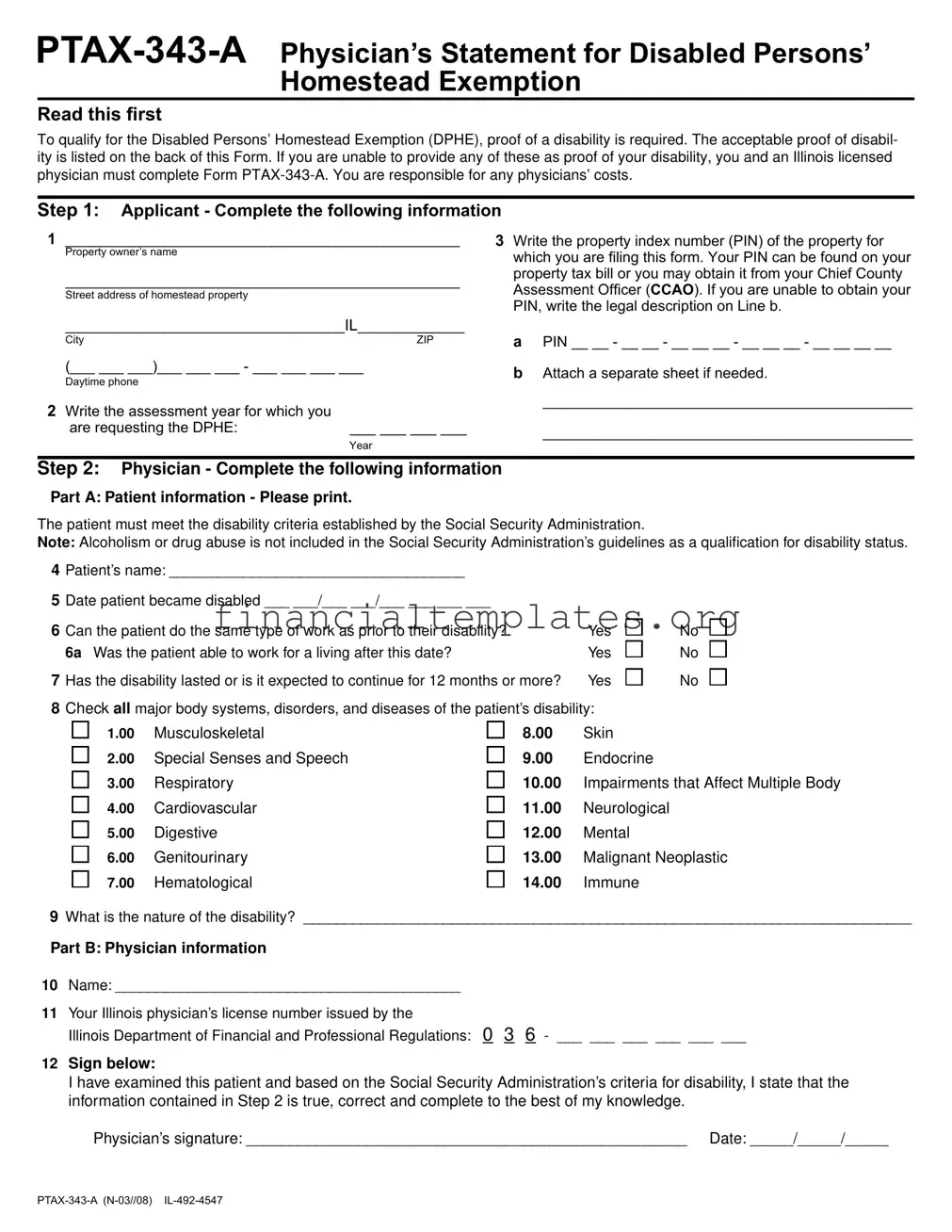PTAX-343-A Physician’s Statement for Disabled Persons’ Homestead Exemption
Read this first
To qualify for the Disabled Persons’ Homestead Exemption (DPHE), proof of a disability is required. The acceptable proof of disabil- ity is listed on the back of this Form. If you are unable to provide any of these as proof of your disability, you and an Illinois licensed physician must complete Form PTAX-343-A. You are responsible for any physicians’ costs.
Step 1: Applicant - Complete the following information
1________________________________________________
Property owner’s name
________________________________________________
Street address of homestead property
3Write the property index number (PIN) of the property for which you are fi ling this form. Your PIN can be found on your property tax bill or you may obtain it from your Chief County Assessment Officer (CCAO). If you are unable to obtain your PIN, write the legal description on Line b.
__________________________________IL_____________
(___ ___ ___)___ ___ ___ - ___ ___ ___ ___
Daytime phone
2Write the assessment year for which you
are requesting the DPHE: |
___ ___ ___ ___ |
|
Year |
aPIN __ __ - __ __ - __ __ __ - __ __ __ - __ __ __ __
bAttach a separate sheet if needed.
_____________________________________________
_____________________________________________
Step 2: Physician - Complete the following information
Part A: Patient information - Please print.
The patient must meet the disability criteria established by the Social Security Administration.
Note: Alcoholism or drug abuse is not included in the Social Security Administration’s guidelines as a qualification for disability status.
4Patient’s name: ____________________________________
5Date patient became disabled ___ ___/___ ___/___ ___ ___ ___
6 |
Can the patient do the same type of work as prior to their disability? |
Yes |
|
6a Was the patient able to work for a living after this date? |
Yes |
7 |
Has the disability lasted or is it expected to continue for 12 months or more? |
Yes |
8Check all major body systems, disorders, and diseases of the patient’s disability:
1.00Musculoskeletal
2.00Special Senses and Speech
3.00Respiratory
4.00Cardiovascular
5.00Digestive
6.00Genitourinary
7.00Hematological
8.00Skin
9.00Endocrine
10.00Impairments that Affect Multiple Body
11.00Neurological
12.00Mental
13.00Malignant Neoplastic
14.00Immune
9What is the nature of the disability? __________________________________________________________________________
Part B: Physician information
10Name: __________________________________________
11Your Illinois physician’s license number issued by the
Illinois Department of Financial and Professional Regulations: 0 3 6 - ___ ___ ___ ___ ___ ___
12Sign below:
I have examined this patient and based on the Social Security Administration’s criteria for disability, I state that the information contained in Step 2 is true, correct and complete to the best of my knowledge.
Physician’s signature: ___________________________________________________ Date: _____/_____/_____
PTAX-343-A (N-03//08) IL-492-4547

To qualify for the Disabled Persons’ Homestead Exemption (DPHE), proof of a disability is required. The acceptable proof of disability is listed below. If you are unable to provide any of these as proof of your disability, you and an Illinois licensed physician must complete Form PTAX-343-A.
You are responsible for any physicians’ costs.
What is considered proof of disability?
1A Class 2 Illinois Disabled Person Identification Card from the Illinois Secretary of State’s Office. Class 2 or Class 2A qualifies, Class 1 or 1A does not qualify.
2Proof of Social Security Administration (SSA) disability benefits which includes an award letter, verification letter or annual Cost of Living Adjustment (COLA) letter
(only Form SSA-4926-SM-DI). If you are under the age of 65 receiving Supplemental Security Income (SSI) disability benefits, proof includes a letter indicating SSI payments (SSA-L8151, SSA-L8155, or SSA-L8156).
3Proof of Veterans Administration disability benefits which includes an award letter or verification letter indicating you are receiving a pension for a non-service connected disability.
4Proof of Railroad or Civil Service disability benefits which includes an award letter or verification letter of total (100%) disability.
When and where must I file this Form PTAX-343-A?
You must fi le Form PTAX-343- A with your Chief County Assessment Officer (CCAO) at the address shown below prior to your county’s due date for the Disabled Persons’ Homestead Exemption (DPHE). Contact your CCAO at the telephone number or address below for assistance.
File or mail your completed Form PTAX-343-A:
_______________________________________ County, CCAO
____________________________________________________
Mailing address
If you have any questions, please call: (____)_____-________
Social Security Administration’s Listing of Impairments
The Listing of Impairments describes, for each major body system, impairments that are considered severe enough to prevent a person from doing any gainful activity. Most of the listed impairments are permanent or expected to result in death, or a specific state- ment of duration is made. For all others, the evidence must show that the impairment has lasted or is expected to last for a continuous period of at least 12 months. The criteria in the listing of impairments are applicable to evaluation of claims for disability benefits from the Social Security Administration (SSA). Visit SSA web site for more specific information.
1.00 |
Musculoskeletal System |
8.00 |
Skin Disorders |
2.00 |
Special Senses and Speech |
9.00 |
Endocrine System |
3.00 |
Respiratory System |
10.00 |
Impairments that Affect Multiple Body Systems |
4.00 |
Cardiovascular System |
11.00 |
Neurological |
5.00 |
Digestive System |
12.00 |
Mental Disorders |
6.00 |
Genitourinary System |
13.00 |
Malignant Neoplastic Diseases |
7.00 |
Hematological Disorders |
14.00 |
Immune System |
|
|
|
Offi cial use. Do not write in this space. |
|
|
Date received: ___ ___/___ ___/___ ___ ___ ___ |
DFPR license verifi ed: ___ ___/___ ___/___ ___ ___ ___ |
Month |
Day |
Year |
Month |
Day |
Year |
|
|
|
Comments:______________________________________________
_______________________________________________________
_______________________________________________________


